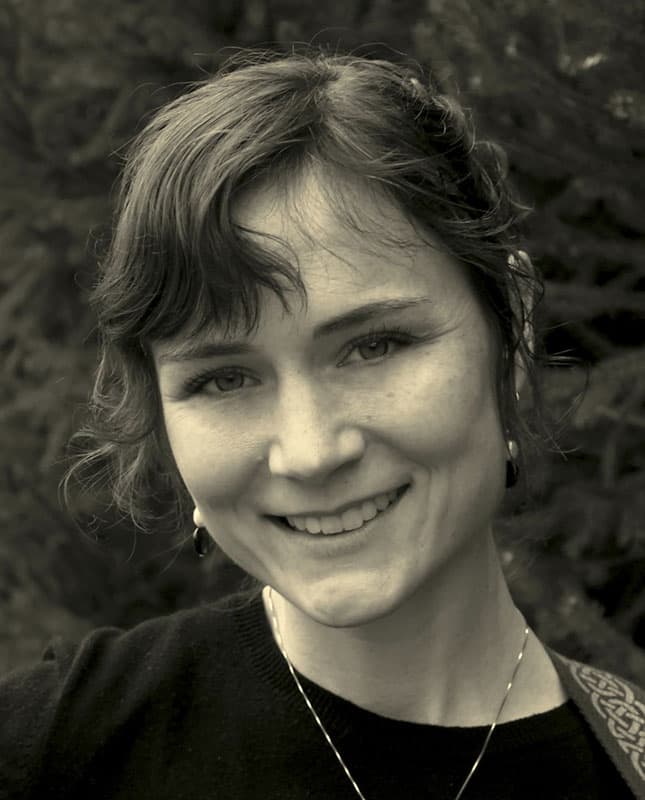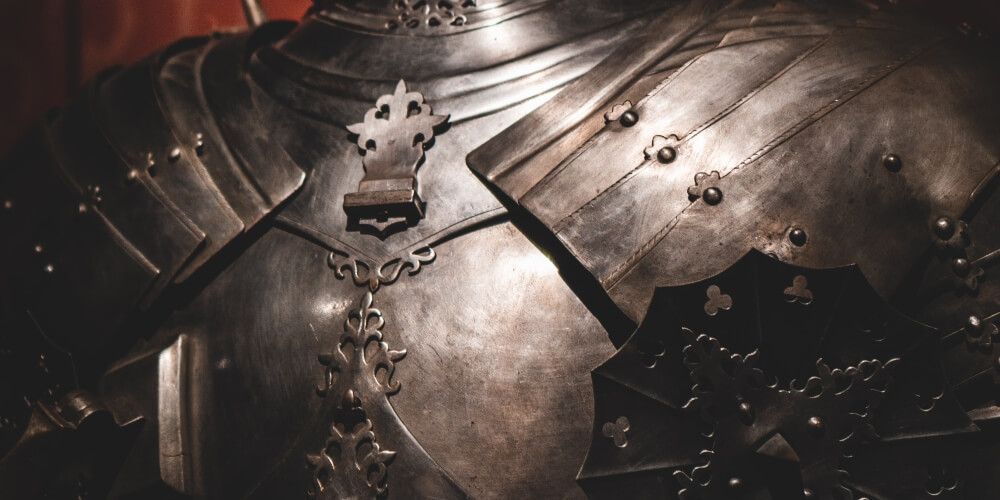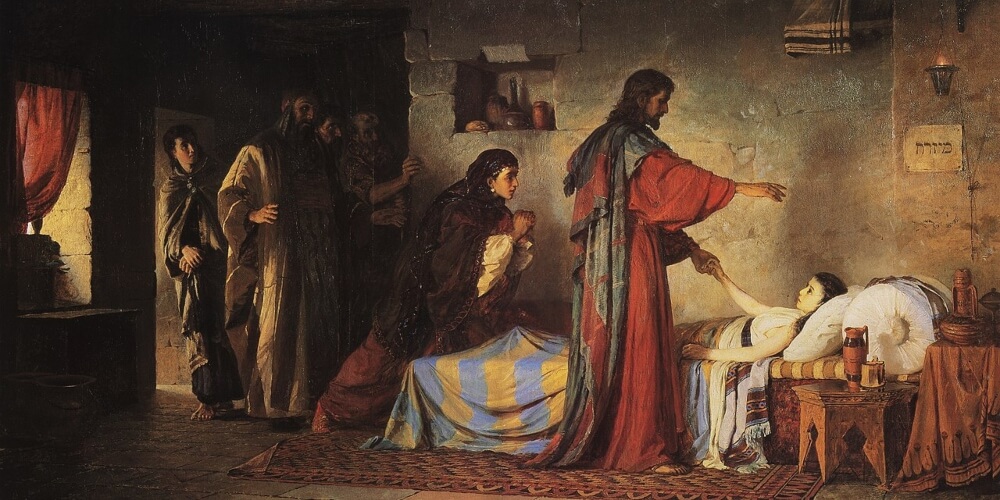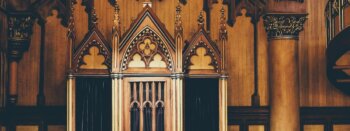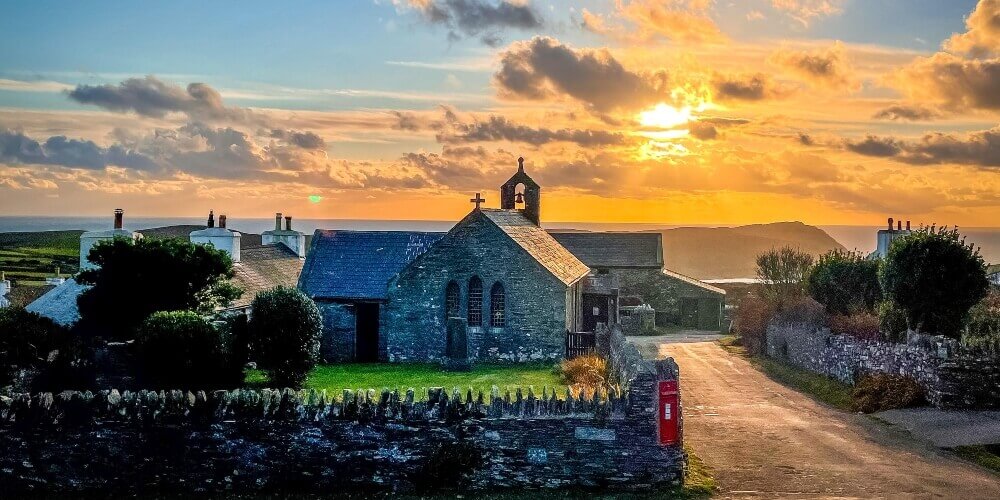
In September, Good Catholic writer Rachel Shrader spent two weeks exploring the hidden paths of Catholicism in England, Ireland, and Wales. We invite you on this epic journey, which will take you from an oasis of grace in post-Catholic Dublin, to London’s National March for Life, to the healing waters of Britain’s oldest shrine. We’ll be posting about it over the next several weeks, so bookmark the Good Catholic Blog to catch all the action!
I was late.
I crept into St. Kevin’s Church deep into the 8 a.m. Mass I had planned to attend. Having flown into Dublin from the United States just a few hours before, major delays at the airport and rush-hour traffic meant that I was nowhere near on time despite landing at 5:20 a.m.
I knelt down in an inconspicuous corner of the shadowy, beautiful church as the priest went on with the liturgy. He hadn’t seen me; he was facing the altar, celebrating a Latin Mass, absorbed in the prayers heard only by God in that most sacred part of the liturgy.
Not many people were there—but a few were. One of them I would see at a different church later that day.
It wasn’t much, in the eyes of an observer—but it was definitely something. And what was happening on the altar—well, that was everything, especially in such a spiritual wasteland as Dublin, Ireland, in the year 2022.
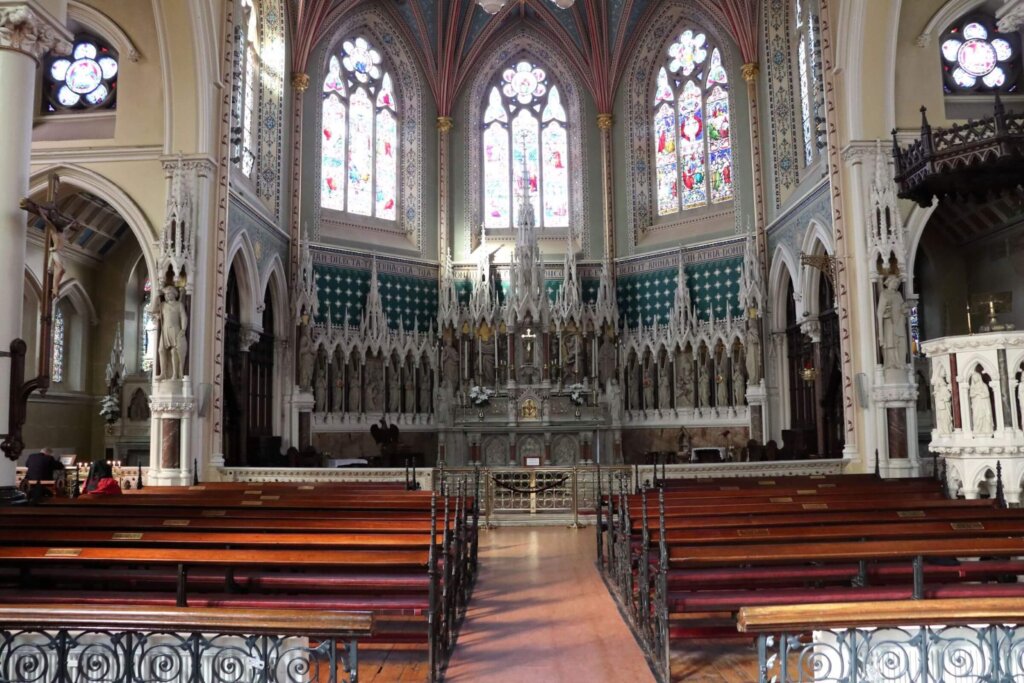
Later that morning—revitalized by a much-needed latte and the best pancakes I’d ever had—I knocked on the door of the great stone presbytery (presbytery = rectory in American English) next door to the church. The door was answered by a smiling Fr. Gerard Deighan. He is head of the Dublin Oratory in Formation, which is the small community in charge of St. Kevin’s Church.
Our hour-long conversation involved mostly listening on my part. I had much to learn, being an American who had never experienced on-the-ground Irish Catholicism in her life.

What I experienced was not merely a nice chat about a beautiful church in a popular foreign city, granted for the sake of a traveler’s curiosity.
The story I heard was a universal one, a lesson from a corner of Christendom to which vast numbers of Americans can trace their ancestry—and their faith. It was a tale that took me far away to Rome, to England, and back to Dublin; it involved a religious order whose way of life would impress me profoundly and unexpectedly; it was a tale that featured the joint work of clergy and laity laboring together to build up the Faith in the midst of a hostile world. It was an ongoing saga of fortitude, courage, and hope.
In short, it was everything you want in a story, and it made for the perfect beginning to a two-week adventure into the vibrant havens of Catholicism in northwest Britain.
Meet the Oratorians
The Vision of St. Philip Neri
First things first.
What is an Oratory, or as the case might be, an Oratory in Formation? Just who are these priests and brothers at work here in the heart of Ireland’s capital city?
The Oratorians are a Society of Apostolic Life founded by St. Philip Neri in Rome in the 16th century.
An Oratory is an established house of the Oratorians—perhaps you’ve heard of such luminaries as the London (“Brompton”) Oratory. Newly-established houses such as Dublin’s are called “Oratories in Formation.” (Another tip for my fellow-Americans: it’s pronounced OR-ah-tree in three sweeping syllables, not OR-ah-tor-ee in a clunky four.)
“To understand the Oratory you need to understand St. Philip Neri, whose portrait is there,” Fr. Deighan said. He proceeded to give a brief sketch of the saint whose large painting looked at us from the wall across the distinguished parlor in which we sat.
St. Philip was from Florence but moved to Rome as a young man, living there as a layman before becoming a priest at age thirty-six. It was a time of rampant corruption among the clergy and Curia and of failing faith among the people in Rome. This simple, joyful man reformed the city so thoroughly that the Church calls him “the second Apostle of Rome.”

Philip was known for his ministry to young people, said Fr. Deighan, particularly young men. He would gather them together for prayer, instruction, singing, and fellowship in the afternoons, diverting them from dangerous idleness to a soul-enriching occupation. The room where this took place and the activity itself became known as “the Oratory.”
This ministry was just what the Church needed to revitalize the faith of the people. The project took on the character of a religious community as it gained followers, some of whom were ordained and assisted Philip in his priestly duties.
St. Philip had no intention for his project to spread beyond its single location at the Chiesa Nuova in Rome.
“But of course,” Fr. Deighan said, “it was too good to keep in Rome, and so they started in Naples and in various other locations in Italy, always just with the spirit of his life, and his manner of dealing with people, which was joyful, simple, direct, which was unusual in those days, you see.”
He explained that preaching was complicated and long, with priests aloof and removed from the people, in addition to the problems of corruption.
“St. Philip just wanted his priests to speak directly to the people, and to have a familiar, cheerful way,” he said.
Other Oratories then sprang up. Today you can count eighty-six throughout the world. All are bound together loosely in a Confederation of Oratories, with a head office in Rome.
The “Second” Founder
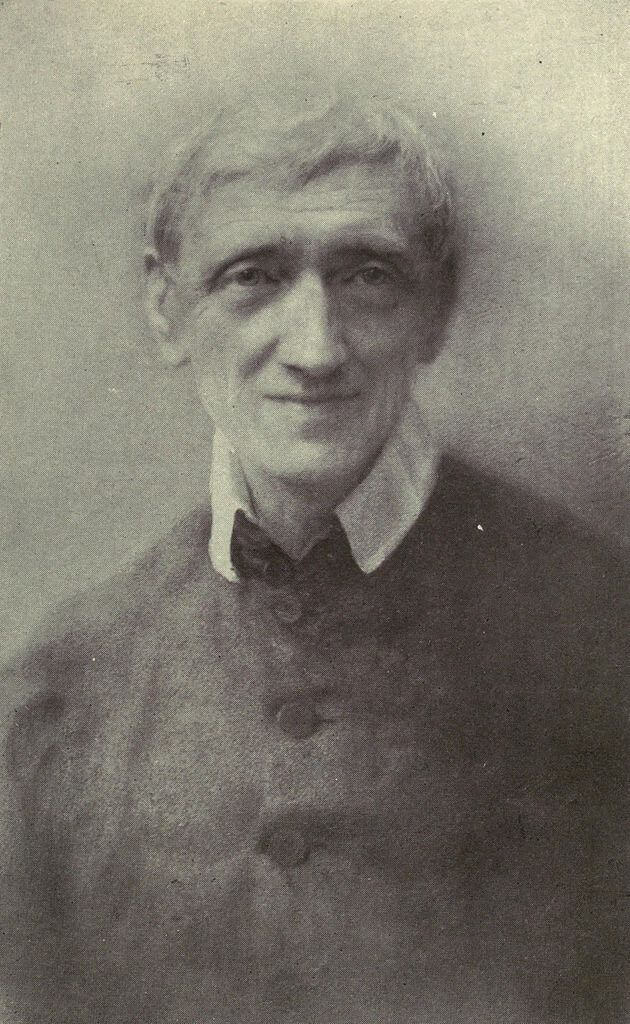
“A major event in the life of the Oratory worldwide was this man’s conversion to Catholicism,” Fr. Deighan said, gesturing towards another portrait that hung nearer to us in the parlor. “St. John Henry Newman.”
Newman was an enormously high-profile figure (both within the Church of England and in intellectual circles) when he—an Anglican priest and well-known scholar at Oxford—became a Catholic in 1845.
“A big win for the Church,” Fr. Deighan said, adding with a laugh, “even bigger than Shia LaBeouf.”
When Newman was ordained a Catholic priest in Rome, he sought a religious community that would best replicate the type of life he experienced during his time at Oxford: a life of communal life, prayer, and study, but with more freedom than a monastic community.
He found what he was looking for in the Oratorians. After joining them in Rome, he returned to England and founded the United Kingdom’s first Oratory at Birmingham. The Oratory took root in England readily, and the Oratorians have been a vital part of English Catholicism ever since.
“In more recent times there has been a re-flowering of Oratories throughout the world, including in England,” Fr. Deighan said. He mentioned the relatively-new Oratories in Oxford, Manchester, and York, and the Oratories in Formation in Cardiff, Bournemouth, and here in Ireland’s capital.
The Rocky Road to Dublin
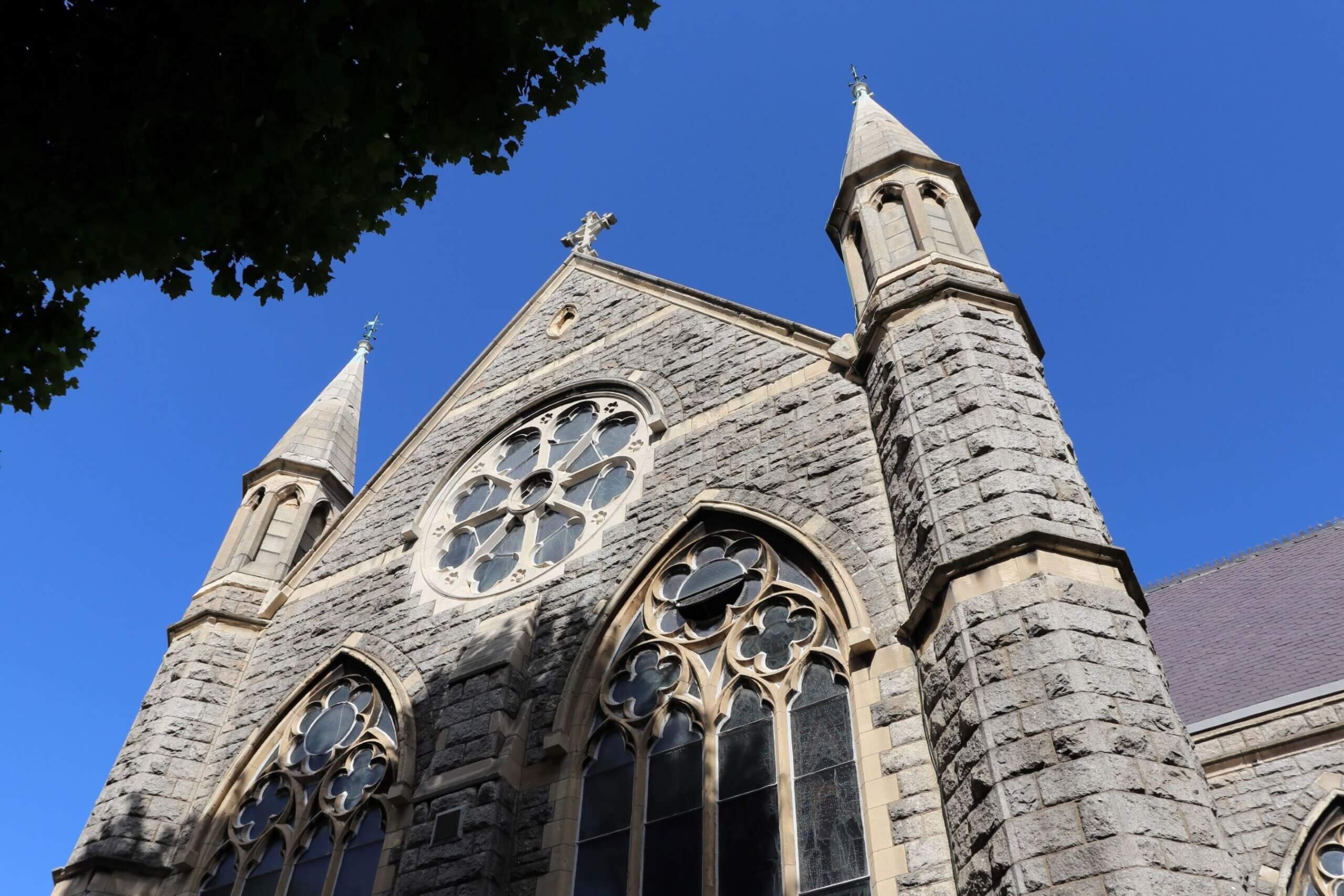
The Dublin Oratory in Formation has only been around since February of 2020. Yet its roots go back much further than that—back, in fact, to Newman himself.
Newman had the idea, documented in his letters, to found an Oratory in Dublin, and it looked as though it might happen when he was offered the rectorship of the newly-created Catholic University of Ireland.
But the rectorship ended after seven years, and the Oratory never came to be. At least, not at that time.
Over a century and a half later, however, the dream would arise again—this time in the mind of Fr. Deighan, a diocesan priest who was entrusted with establishing a Latin Mass chaplaincy at St. Kevin’s in 2007 following Benedict XVI’s Motu Proprio Summorum Pontificum.
“But I had always had it in my mind from the time of my ordination that it would be great to be an Oratorian,” he said.
Now, Oratories are rather unique in the way they propagate themselves. Most religious institutions do so by sending a band of experienced religious to another location to start a new community.
Oratories have used this method, but they can also come together if several people—preferably four or more, including a priest or two—decide to begin one. They receive the approval of the bishop and the Oratorian Procurator in Rome, and are established as an Oratory in Formation for at least three years. If all goes well, they receive full approbation and become a fully-fledged Oratory.
When Fr. Deighan came to St. Kevin’s as a diocesan priest and saw the place, he thought, “This is amazing. This would just be a perfect environment, perfect location and church and house to have an Oratory.”
The bishop and the head Oratory in Rome being open to it (together with three priests and three laymen lined up to start this new Oratory) it seemed that things were falling into place.
But more patience would be required. As in Newman’s day, the project stalled and nothing came of it. Meanwhile Fr. Deighan continued his ministry at St. Kevin’s, and the Latin Mass chaplaincy flourished.
Eleven years would pass.
Then, a few months before the canonization of Cardinal Newman in 2019, Fr. Deighan received two very interesting visitors at St. Kevin’s.
All In God’s Good Time
The two men who came to visit Fr. Deighan were early-stage Dominicans. Incredibly, one of them had been one of the would-be Oratorians from years before.
They persuaded Fr. Deighan that, with the canonization coming up, it was time to try again.
Was it indeed.
Approval from the bishop and the Roman authorities was immediate, and with two priests and two seminarians as their founding faculty, the Dublin Oratory in Formation was born at last on February 2nd, 2020.
It had taken 165 years to get this thing from the mind of Newman to the streets of Dublin. But here it was. It’s now approaching its three year anniversary in February 2023 when, God-willing, it will qualify to become an Oratory.
Could You Handle Oratory Life?
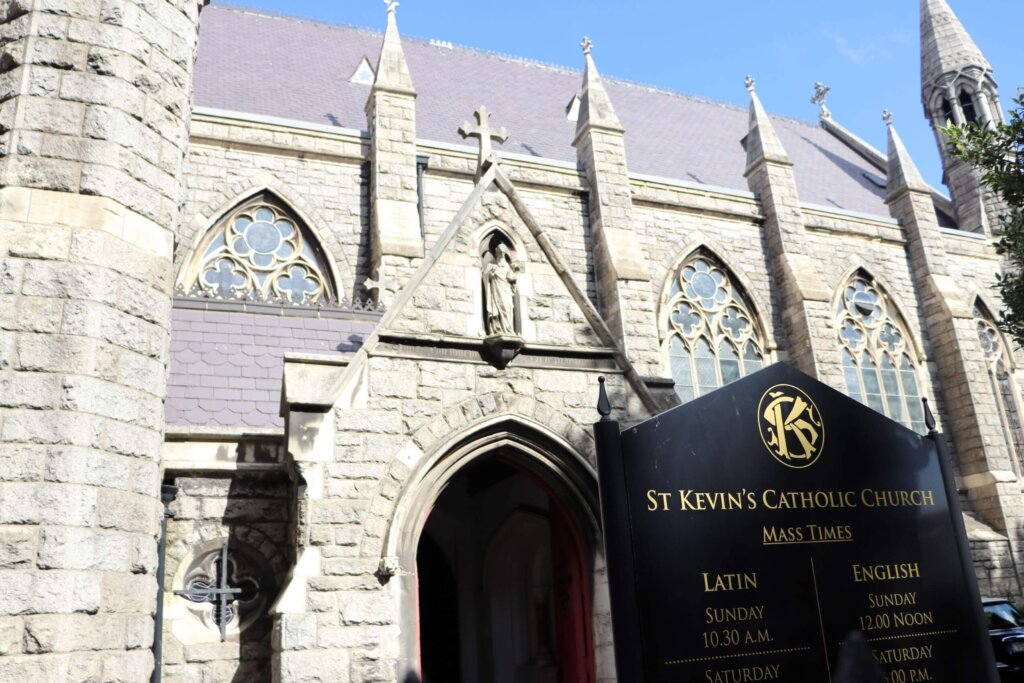
So what is life like in an Oratory?
The religious that populate one are an assortment of ordained priests and brothers, who are usually, though not always, studying for the priesthood.
An Oratorian house is, importantly, a spiritual family. Therefore the numbers are always small—between four and twelve men. As families do, Oratorians keep a regular common life, with regular prayer and meals together.
In keeping with their integral call to parish ministry, each Oratory maintains a public church that is generally kept open and available for personal prayer, where Mass is celebrated multiple times a day, and where the priests offer Confession daily.
Those called “Newmanite” Oratories—that is, those that take their charism from Newman—tend to celebrate the liturgy both in English and in Latin, whether in the older or newer forms.
At St. Kevin’s, incidentally, both Masses were celebrated even before the founding of the Oratory, since Fr. Deighan is both the parish priest of St. Kevin’s (in which capacity he celebrates the English Mass) and the chaplain of the Latin Mass Chaplaincy.
But here’s the real kicker. The thing that makes you stop and wonder who these Oratorians really are.
“Probably the most characteristic thing about the life of an Oratorian as opposed to any other religious institute or Institute of Apostolic Life is the aspect of stability,” Fr. Deighan stated.
“When you enter the Dublin Oratory,” he said, simply but seriously, “you’re entering here for life. You’re going to die here. There’s no moving around.”
If you’re a Get Fed reader, I’ve written about this concept before in the context of such religious orders as the Benedictines, who literally vow themselves to a lifetime of stability (see that article here).
While the Oratorians do not take vows—Societies of Apostolic Life and secular priests do not take vows as religious orders do—the commitment runs just as deep and brings a distinctive character to their life and work.
In terms of the house itself, it brings a profound commitment to one’s fellow-Oratorians—and a whole new dimension to the abovementioned idea of the “spiritual family.” When a man enters an Oratory, he is committing himself not just to an idea or a rule, but to this particular house, with these specific people, for the rest of his life.
That’s a daring commitment for our commitment-shy, self-centered, comfort-obsessed society.
Now, to be fair, my fascination with the subject of stability springs in part from the hyper-mobility and rootlessness of American society. This is not an Irish problem, Fr. Deighan explained to me, since they are much more attached to their home regions.
But there’s more to this “spiritual family” idea. The stability of an Oratory means that the priests and brothers serve one particular parish for life, which produces a profound bond with the people they serve.
They form relationships with these families that can span generations—a priest might baptize a child then later perform his wedding ceremony. That’s a deep reality of community and continuity.
In fact, the people who come to the Oratory church actually form part of the Oratorian family. While the brothers and priests are called the Congregation of the Oratory, the Dublin Oratory, properly-speaking, includes clergy and laity together.
It’s a startling way of life. Finding an Oratory is like finding something real in a video-game world, or stepping from a mad rush into a peaceful sanctuary. In the midst of a world always moving too fast and changing too much—a world in which truth is constantly questioned and re-defined—this is a place where real, true things remain and thrive. This is a “safe space” properly defined.
Like the churches they inhabit (which, in the case of the UK and Ireland, are almost always old, large, and beautiful) these are institutions built to last.
Even now, weeks and weeks later, I’m still in awe of it.
Will The Faith Stay Alive in Ireland?
A Dire Situation
In the 1960s, the Irish seminary at Maynooth was the largest in the world with 600 students.
Now that same seminary—the only one left in the country—has but a couple dozen or so. The Archdiocese of Dublin has one seminarian—and he’s at the Dublin Oratory.
This doesn’t bode well for the 200 or so parishes in the Archdiocese of Dublin. According to Fr. Deighan, the plan is to form them into groups of 8-12 within the next five years, with two or three priests for each group. It’s certainly not a model based on hopeful vocational projections.
And the faith of the people? One need only look at the results of Ireland’s recent referenda on abortion and homosexual marriage to see where the belief of the people stands.
“It’s that old saying,” Fr. Deighan said, “that the corruptio optimi pessima—the corruption of the best thing is the worst type of corruption.”
He said that Ireland had been one of the best in terms of the strength of the Catholic Faith. Now it’s in a worse state, perhaps, than any place in the world—this country once so thoroughly devoted to her Catholic faith, having fought so long and hard for the freedom to practice it.
In the face of such a tragedy, it’s tempting to give the whole thing up as a lost cause. Who could save Ireland now?
A Light in the Darkness
I knew as well as anyone that the Irish were in dire straits. But I hadn’t come to Dublin looking for a tragedy—and one thing I would learn about Oratorians is that hurry, panic, discouragement, and preoccupation with statistics are all equally foreign to them.
Oratorians just…do what they do. They celebrate Mass, they welcome people into their church, they hear Confessions—day in and day out. They don’t relocate, they don’t hurry—and they don’t give up. I like to call it the “Oratorian pace.”
Miraculously, the results seem to follow.
Although he was perfectly realistic about the environment he worked in and about his own status as an endangered species, the Irish priest I was talking to that day did not seem at all despondent about his situation.
The tale of his parish—with its living witness of faith—was one that could give even a pessimist real hope.
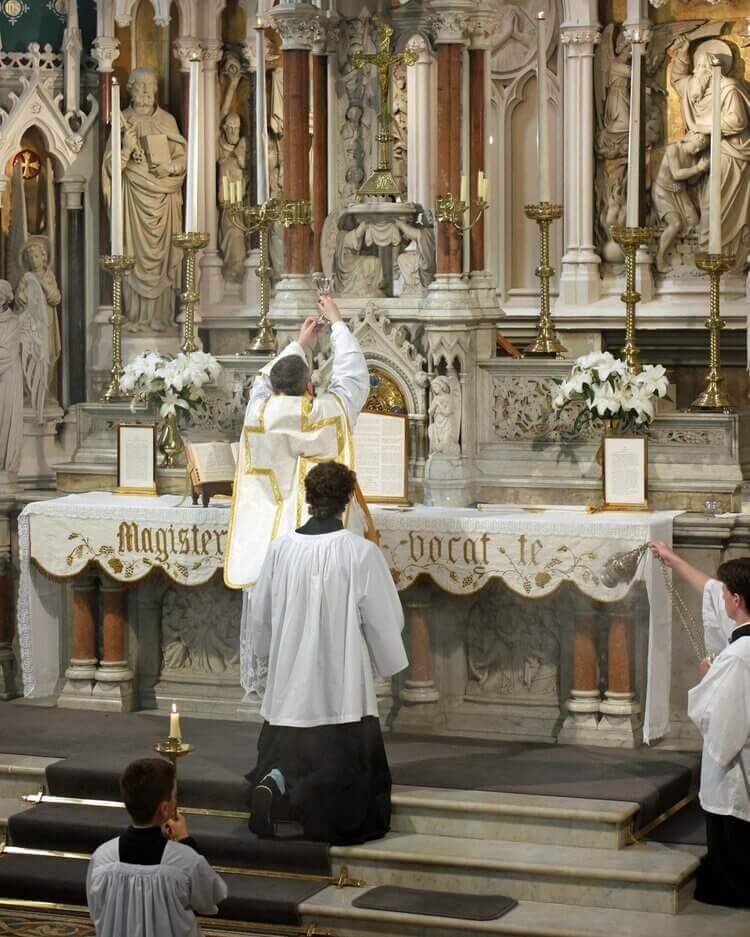
He said that this congregation was the finest he’d ever been assigned to and noted how rewarding it was to work with people committed to their faith—in contrast to the experience of many Irish priests who are faced with people who feel entitled to things like Baptism and a Catholic funeral but have little belief.
Since COVID times, the Oratorians of St. Kevin’s noticed an increase in attendance at their parish, and a decrease in the average age.
This youthful crowd is particularly drawn to the Latin Mass, which is celebrated twice on Sunday mornings. Between those two Masses, St. Kevin’s welcomes 500-600 (and increasingly more) faithful each week, coming from as far away as 50 miles.
“It’s a pity you’re not here on Sunday to see it,” Fr. Deighan said to me, “because it’s really quite a phenomenon to see the youth of the congregation.” (Note to self: I am obliged to come back very soon, on a Sunday). Visiting priests have said that there is no congregation in Ireland as large or as young.
Fr. Deighan also noted that the priests are “swamped” with confessions, which is always a great sign of sincere and ardent faith. St. Kevin’s being the only parish in the city that offers confessions on Sundays—the most convenient time for out-of-towners—two priests hear confessions on Sunday morning. (During Mass, if necessary!)
It’s Like “Meeting This Wonderful Bride”
With the decline of authentic Catholicism in Ireland, Fr. Deighan explained that people of faith are simply going to have to unite and build up strong communities of faith again.
He says that this is what is happening at St. Kevin’s, with the traditional Mass as the rallying point. He then went on to explain why the young congregation of St. Kevin’s—and he himself—find it so attractive.
“[The Latin Mass] just is such a wonderful vehicle for evangelization,” he said, “spreading the Faith, while not appearing to do so at all, but it just draws people like a magnet, young people, and they’re fascinated by it. And it’s genuine, it’s not a superficial thing, they keep coming back. They’ll spend an hour and half at Mass and they’ll go to Confession. This would not be happening if it wasn’t the traditional Mass.”
“As a boy myself when I was sixteen I saw the old Mass and immediately I was in love,” he said. “So I know the experience that young people have, I had it myself— and I continue to have it, actually!”
Then he said the most beautiful thing I’d ever heard a priest say about celebrating the Mass.
“Obviously Mass is always Mass, but with the old Mass you go out with a joy, that you’re meeting this wonderful bride, again, for the first time.”
These words were especially poignant coming from an experienced parish priest who had been ordained for three decades and was far past the honeymoon phase of his spiritual marriage to the Church. For him, this truly was “beauty ever ancient, ever new,” as St. Augustine named it—it was a love that never grew old, even in the battle-worn trenches of post-Catholic Ireland.
Only later did I connect Fr. Deighan’s words to the opening words of the priest in the Latin Mass—the first phrase of the preparatory psalm that is said as the priest stands before the altar:
Introibo ad altare Dei—ad Deum qui laetificat juventutem meam.
I will go in to the altar of God—to God who giveth joy to my youth.
Until We Meet Again
As we finished our conversation in the presbytery of St. Kevin’s, Fr. Deighan gave me a little booklet containing a novena to St. Philip Neri penned by St. John Henry Newman. Each day of the novena—which is prayed leading up to St. Philip’s May 26th feast day—contained an in-depth meditation on some aspect of St. Philip’s life and spirituality.
I didn’t know it at that point in my trip, but I would meet the Oratorians again in short order. In fact, they would figure prominently into my entire trip. I had only planned to visit one Oratory, but by the time I left the UK a fortnight later, Providence had guided me to three.
Their striking spirituality—contained in the novena book I now carried with me— would gradually make a deep impact on me as I explored the sacred sites of the United Kingdom. It would occur to me, in time, how well-suited they were to the challenges of modern Britain and Ireland: their stability; their immovable, beautiful churches; their ordinariness; their steadiness; the peace that radiated from them; the indissoluble connection to St. John Henry Newman that gave them an irrevocable place in these British Isles.
We’ll talk more about the Oratorians as we meet them later on in our exploration of Catholic England and Wales.
For now, let’s say a proper goodbye to Dublin.
The Fire of Ancient Faith
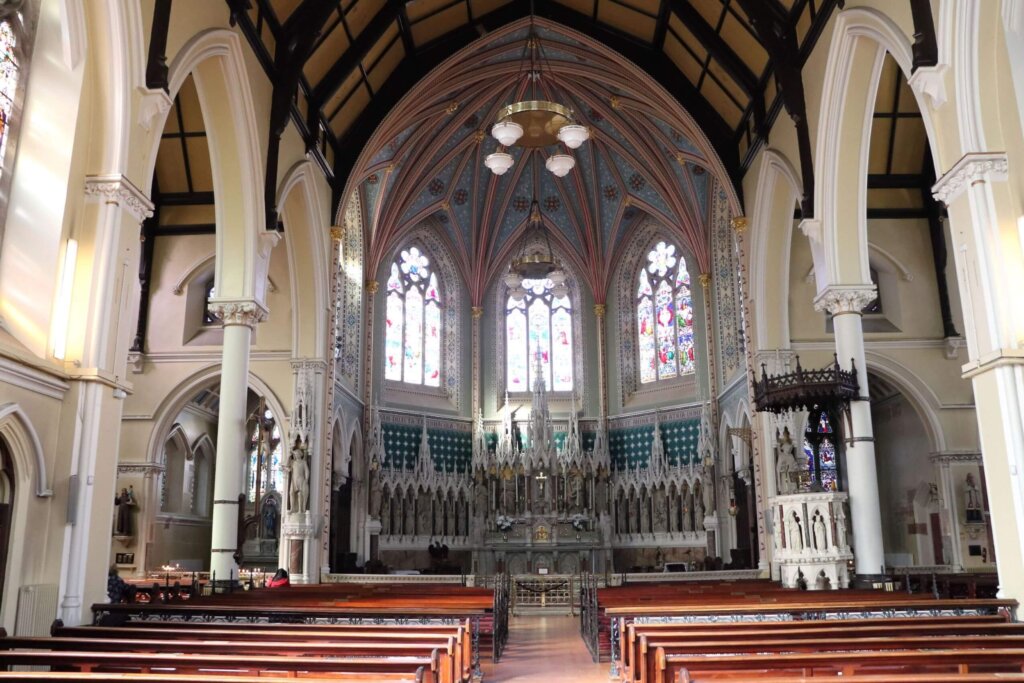
Before I left to explore the city for the rest of the day and catch an evening flight to Manchester, I took a good wander around St. Kevin’s, admiring its glorious interior and taking copious pictures for you, our readers.
It’s every bit as beautiful as you’d think an 1872 neo-Gothic Catholic church should be in Ireland.
Its apse is clothed in delicate brocade of blue, red, and royal gold, its rear wall painted in vivid green. The ornate reredos (the backdrop to the high altar) rises into a spire that points from the golden tabernacle up to the stained glass image of the Crucified. This vertical draw continues upward to the celestial point of the window and of the Gothic ribbing in the apse.
The reredos extends from side to side, sheltering two ranks of angels keeping vigil near their Lord. Beautifully-wrought stone statues of St. Michael the Archangel and his compatriot St. Gabriel guard the entrance to the sanctuary.
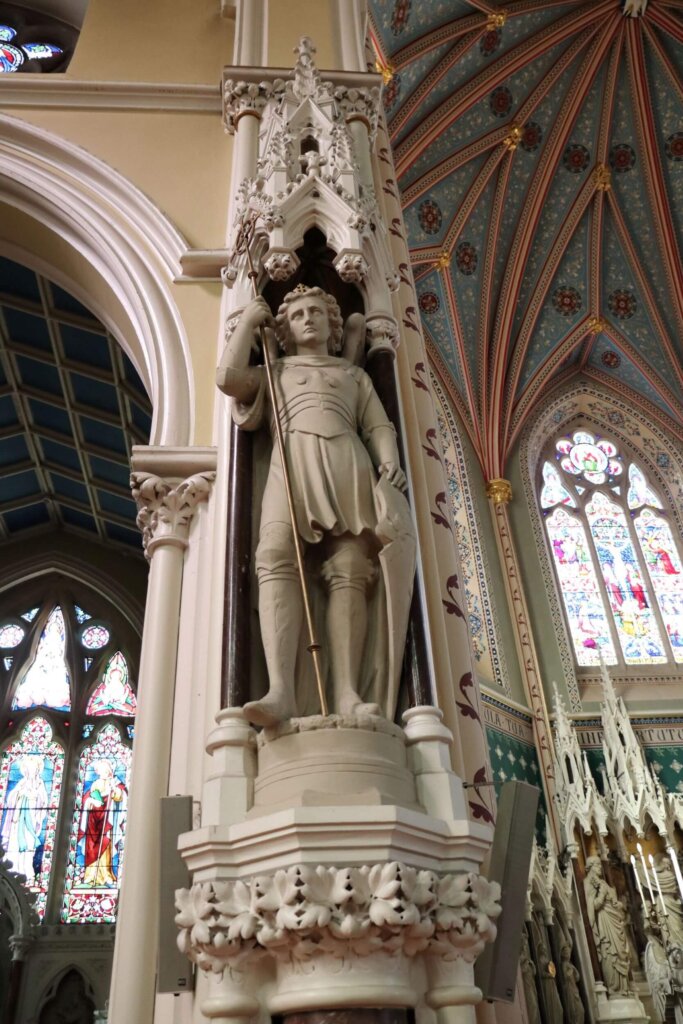
Side altars offer a place of prayer and rest for the faithful who come to light candles there. From the right altar, portraits of St. Philip Neri and St. John Henry Newman gaze peacefully outward, guarding with their prayers and intercession this place under their particular patronage.
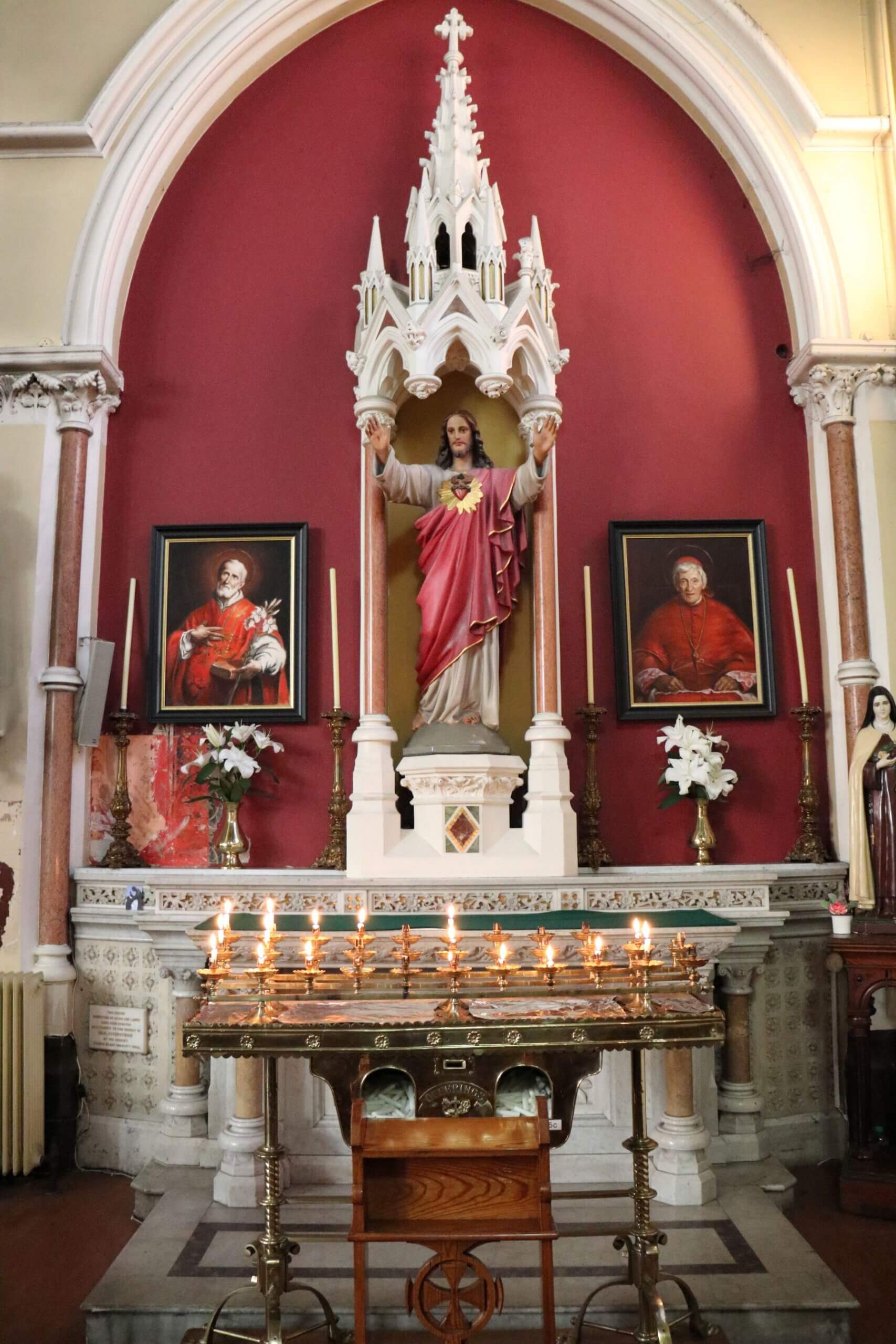
A traditionally-styled pulpit rises in the midst of the pews, complete with a staircase and a dark wooden canopy. Sunlight filters in through the colorful windows. A great pipe organ presides over the choir loft.
It is a place that is “ancient but new,” one that breathes a continuing, flourishing life.
And life it has.
Life Himself is there inside the tabernacle, quiet and unnoticeable if you didn’t know He was present. The world rushes around outside, forgetful of its Catholic roots, long history of faith, and the Divine Resident of its failing churches.
But things are different here.
Something is happening here.
Here, in this place, the steady, simple work of a remarkable community is having its effect. Here, the Lord is loved, adored, reverenced, and received. In this sacred structure, life flows from its Divine Heart—Christ Himself—in the tabernacle outward into His Members, into loving souls who peacefully and joyfully tend the fires of an ancient faith.
Continue, my friends, and may you set all of Ireland aflame. +
